Traditional tzatziki sauce is a beloved Greek dip that has a refreshing and tangy flavor. To recreate this classic delicacy, it’s essential to know the ingredients that go into making it.
Traditional tzatziki sauce is made with simple ingredients including strained Greek yogurt, cucumber, garlic, and sometimes fresh herbs such as dill or mint. Additional ingredients may include kosher salt, distilled white vinegar, extra virgin olive oil, and ground white or black pepper. The cucumbers used in the sauce should be grated and well-drained before mixing with the other ingredients.
The sauce can be served immediately or refrigerated for a few hours to allow the flavors to meld. It is commonly used as a dip for vegetables or pita bread, as a sauce for gyros or kebabs, or as a condiment for various dishes.
Key Takeaways:
- Traditional tzatziki sauce is a popular Greek dip with a refreshing and tangy flavor.
- The main ingredients in tzatziki sauce include strained Greek yogurt, cucumber, and garlic.
- Additional ingredients such as fresh herbs, kosher salt, vinegar, olive oil, and pepper can be added for extra flavor.
- Grate and drain the cucumber before mixing it with the other ingredients.
- Tzatziki sauce can be served immediately or refrigerated to enhance the flavors.
The Key Ingredients in Traditional Tzatziki Sauce
Tzatziki sauce primarily consists of a few key ingredients that work harmoniously to create its delicious flavor. These include Greek yogurt, cucumber, garlic, dill, and lemon juice. Authentic tzatziki sauce is made with simple, fresh ingredients that truly elevate the taste of this beloved Greek condiment.
Starting with Greek yogurt, this strained version of yogurt provides a rich and creamy base for the sauce. Its smooth texture and tangy taste add depth to the overall flavor. Next, fresh cucumbers are grated and well-drained to ensure the sauce has a refreshing crunch. The cucumbers not only contribute to the texture but also add a hint of coolness to balance the other ingredients.
Garlic is a key player in tzatziki sauce, offering a bold and aromatic flavor that is essential to its authenticity. Fresh dill is often added to the sauce, bringing a fragrant herbaceous note that complements the other ingredients perfectly. Finally, a small amount of lemon juice adds a tangy zing, enhancing the overall taste and adding a bright freshness to the sauce.
| Ingredients | Quantity |
|---|---|
| Greek Yogurt | 1 cup |
| Cucumber | 1 medium, grated and drained |
| Garlic | 2 cloves, minced |
| Dill | 1 tablespoon, chopped |
| Lemon Juice | 1 tablespoon |
These ingredients, when combined in the right proportions, create a creamy, tangy, and refreshing sauce that is perfect for dipping vegetables, spreading on sandwiches, or serving alongside grilled meats. Whether you’re a fan of Greek cuisine or simply looking to add a burst of flavor to your dishes, traditional tzatziki sauce is a versatile and delicious option that will surely impress.
Strained Greek Yogurt: The Creamy Base of Tzatziki Sauce
The foundation of any authentic tzatziki sauce is strained Greek yogurt, known for its rich and creamy consistency. This thick and velvety yogurt is created by straining off the whey, resulting in a more concentrated and luscious texture. The straining process also removes excess moisture, allowing the yogurt to hold its shape and prevent the sauce from becoming watery.
Strained Greek yogurt provides the perfect base for tzatziki sauce due to its tangy flavor and smooth mouthfeel. It adds a delightful creaminess that complements the refreshing cucumber and bold garlic flavors. While regular yogurt can be used as a substitute, it won’t yield the same luxurious texture and authentic taste that strained Greek yogurt offers.
Table: Benefits of Strained Greek Yogurt in Tzatziki Sauce
| Benefits | Description |
|---|---|
| Rich and Creamy Texture | Strained Greek yogurt lends a thick and velvety consistency to tzatziki sauce, creating a luxurious mouthfeel. |
| Tangy Flavor | The yogurt’s natural tanginess adds a delightful zing to the sauce, enhancing its overall taste. |
| Moisture Control | By removing excess moisture, strained Greek yogurt prevents the sauce from becoming watery and maintains its desired thickness. |
| Better Adhesion | The creamy texture of strained Greek yogurt allows the sauce to adhere well to various foods, making it a versatile condiment. |
Next time you whip up a batch of tzatziki sauce, be sure to use strained Greek yogurt as your creamy base. Its luxurious texture and tangy flavor will elevate your sauce to new heights, ensuring an authentic and satisfying culinary experience.
Fresh Cucumber: The Refreshing Crunch in Tzatziki Sauce
Fresh cucumber is a vital ingredient in traditional tzatziki sauce, providing a crisp texture and a cooling taste. When preparing the sauce, it is important to grate the cucumbers and drain them thoroughly to prevent excess moisture. This ensures that the sauce maintains its desired consistency and doesn’t become watery.
The grated cucumber adds a refreshing crunch to the tzatziki sauce, complementing the creamy base of strained Greek yogurt. The combination of these two ingredients creates a harmonious balance of flavors and textures. The coolness of the cucumber provides a refreshing contrast to the tangy and garlicky notes of the sauce.
To illustrate the importance of fresh cucumber in tzatziki sauce, let’s take a look at the table below:
| Ingredient | Role |
|---|---|
| Grated cucumber | Provides a refreshing crunch and cooling taste |
| Strained Greek yogurt | Serves as the creamy base |
| Garlic | Offers a bold and aromatic flavor |
| Dill | Imparts a fragrant and herbaceous note |
| Lemon juice | Adds a tangy and citrusy zing |
So, next time you indulge in tzatziki sauce, remember to appreciate the role of fresh cucumber in enhancing its taste and texture. Its crispy bite and refreshing nature make it a key component of this beloved Greek condiment.
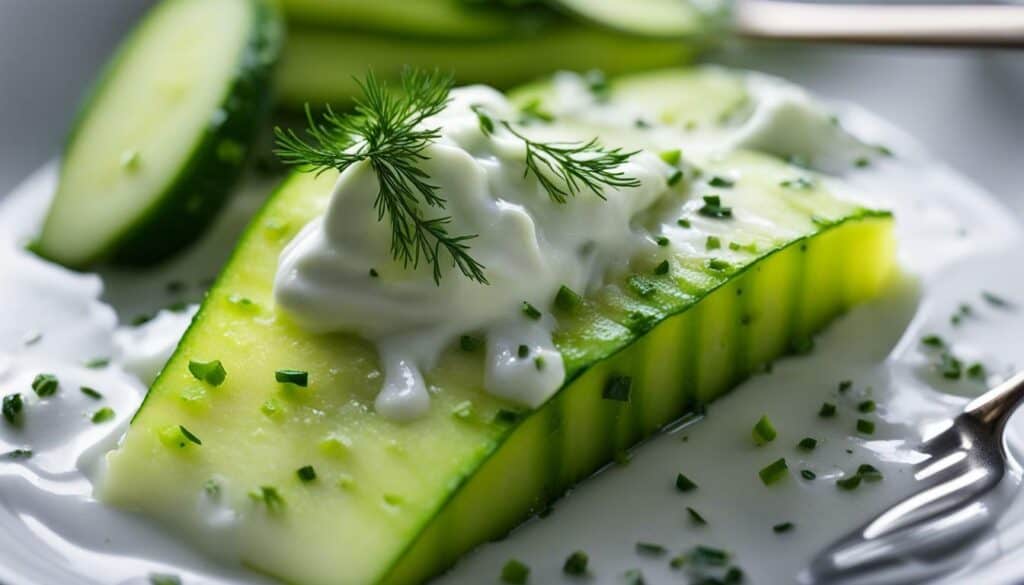
Garlic, with its distinctive flavor and aroma, plays a crucial role in giving tzatziki sauce its bold and tangy taste. This versatile ingredient not only adds a kick to the sauce but also enhances its overall depth. When preparing tzatziki sauce, it is important to use fresh garlic and finely mince it to release its full flavor profile.
One popular technique is to crush the garlic with a garlic press or finely chop it by hand, creating a smooth and intense garlic paste. This paste can then be combined with the other ingredients, allowing the flavors to meld together over time. The garlic paste infuses the sauce with its unmistakable taste, adding a delightful zing to every bite.
When using garlic in tzatziki sauce, it is recommended to start with a small amount and adjust according to personal preference. Some individuals prefer a more subtle garlic flavor, while others enjoy a stronger punch. Experimenting with different quantities allows you to customize the sauce to your liking, creating a truly personalized dipping or condiment experience.
So, the next time you indulge in tzatziki sauce, savor the boldness and aroma of the garlic. Its unmistakable flavor profile adds a unique dimension to this classic Greek sauce, making it a delightful accompaniment to a variety of dishes.

“Garlic transforms tzatziki sauce into a bold and tangy delight, making it the perfect companion for gyros, kebabs, and more!”
But wait, there’s more! Let’s take a look at the other key ingredients that make traditional tzatziki sauce an absolute culinary masterpiece.
| Ingredients | Role |
|---|---|
| Strained Greek yogurt | Provides a creamy base and tangy flavor |
| Cucumber | Brings a refreshing crunch and adds moisture |
| Dill or mint | Infuses the sauce with fragrant herbaceous notes |
| Lemon juice | Brings a tangy zing and balances the flavors |
| Kosher salt | Enhances the overall taste and helps to preserve the sauce |
| Distilled white vinegar | Provides a slight tang and acidity |
| Extra virgin olive oil | Offers richness and depth to the sauce |
| Ground white or black pepper | Adds a subtle hint of heat, if desired |
With these ingredients, you can recreate the authentic flavors of traditional tzatziki sauce right in your own kitchen. Whether you’re dipping veggies, slathering it on pita bread, or serving it alongside your favorite Greek dishes, tzatziki sauce is sure to tantalize your taste buds.
Dill: The Fragrant Herb
Fresh dill, with its fragrant and slightly tangy taste, provides a delightful herbaceous element to traditional tzatziki sauce. This versatile herb is a staple in Greek cuisine, and its inclusion in tzatziki sauce adds a burst of flavor that elevates the overall taste profile. Whether you are a fan of dill or new to its unique taste, incorporating it into your homemade tzatziki sauce is sure to please your taste buds.
When using dill in tzatziki sauce, it is crucial to opt for fresh dill whenever possible. The vibrant green leaves and delicate stems of fresh dill infuse the sauce with a delightful aroma and a subtle hint of citrus. The dill should be finely chopped before adding it to the sauce, ensuring that its flavor evenly distributes throughout.
To maintain the freshness and quality of the dill, store it in the refrigerator in a zip-top bag or wrapped in a damp paper towel. This will help prolong its shelf life and preserve its distinct flavor. When it’s time to prepare your tzatziki sauce, simply remove the desired amount of dill from the refrigerator, wash it thoroughly, and pat it dry before using.
Now that you understand the significance of dill in tzatziki sauce, you can confidently incorporate this fragrant herb into your homemade recipe. Whether you serve it as a dip, sauce, or condiment, the addition of dill will undoubtedly enhance the overall flavor experience. Let the fresh and tangy taste of dill take your tzatziki sauce to new heights of deliciousness.
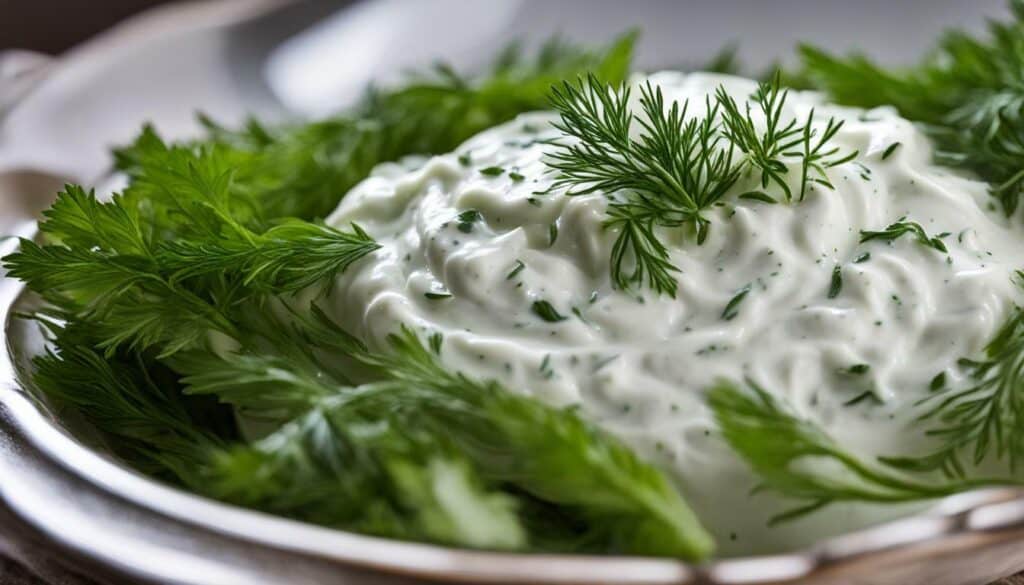
A splash of freshly squeezed lemon juice is the secret ingredient that gives tzatziki sauce its tangy and refreshing kick. The bright acidity of lemon juice not only enhances the flavors of the other ingredients but also adds a zesty zing that cuts through the richness of the yogurt and complements the coolness of the cucumber.
In traditional tzatziki sauce, lemon juice is typically added to taste. Start with a small amount and adjust according to your preference, keeping in mind that a little goes a long way. The goal is to achieve a balance between the creamy, garlicky base and the bright, citrusy notes of the lemon juice.
When using lemon juice in tzatziki sauce, it’s always best to use freshly squeezed juice for optimal flavor. The natural acidity and freshness of the juice will elevate the overall taste of the sauce. Simply cut a lemon in half and squeeze out the juice, being careful to remove any seeds. Remember to strain the juice to remove any pulp or fiber that could affect the texture of the sauce.
So, the next time you whip up a batch of traditional tzatziki sauce, don’t forget to add a splash of freshly squeezed lemon juice. It will take your homemade sauce to the next level, infusing it with a tangy and refreshing zing that will leave you craving more.

While the core ingredients are essential, additional ingredients such as kosher salt, distilled white vinegar, extra virgin olive oil, and ground white or black pepper can be added to customize tzatziki sauce according to personal taste. These ingredients enhance the overall flavor profile, adding depth and complexity to the sauce.
Kosher salt is often used to season tzatziki sauce, as its coarse texture helps to bring out the flavors of the other ingredients. It provides a subtle hint of saltiness that balances the tanginess of the yogurt and the freshness of the cucumber.
Distilled white vinegar can be used to add a touch of acidity to the sauce, enhancing the refreshing qualities of the cucumber and brightening the overall taste. A small amount goes a long way, so it is important to use it sparingly.
Extra virgin olive oil can be drizzled into the tzatziki sauce for an additional layer of richness and flavor. It adds a subtle fruity and peppery note, complementing the other ingredients and creating a harmonious blend of flavors.
Ground white or black pepper can be used to add a hint of spiciness to the sauce, depending on personal preference. It adds depth and complexity to the overall taste, balancing the coolness of the yogurt and the freshness of the other ingredients.
By experimenting with these additional ingredients and adjusting the quantities to suit your taste, you can create a customized tzatziki sauce that is uniquely your own. Whether you prefer it with a bit more tang, a touch of heat, or a subtle hint of richness, these ingredients allow you to tailor the sauce to your liking.
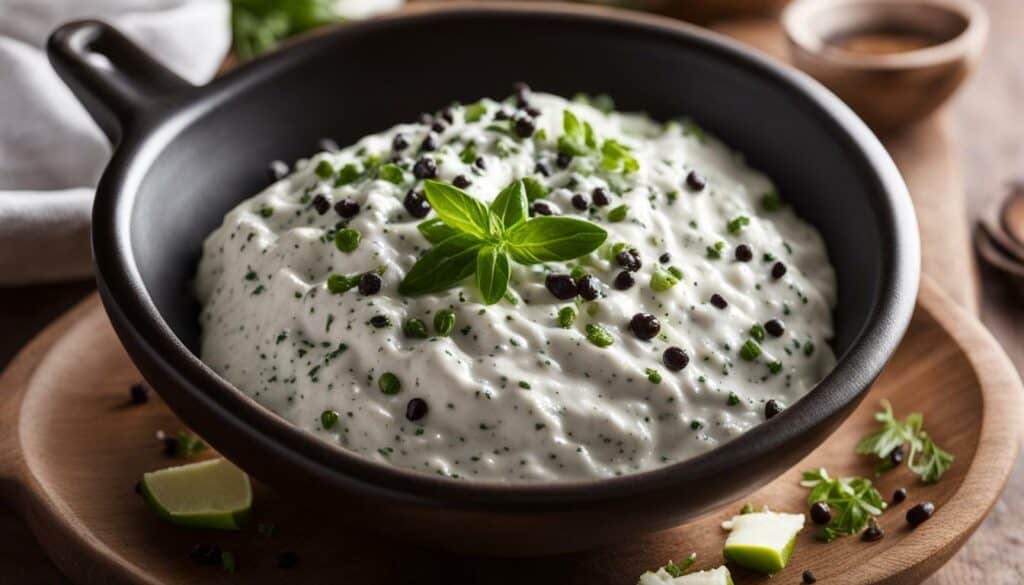
Traditional tzatziki sauce is incredibly versatile and can be enjoyed as a dip, sauce, or condiment. Proper storage and serving techniques ensure its optimal taste and texture.
When serving tzatziki sauce as a dip, it pairs perfectly with fresh vegetables, such as carrot sticks, cucumber slices, or bell pepper strips. You can also serve it alongside warm pita bread or crispy pita chips for a delightful appetizer. The cool and creamy texture of the sauce complements the crispness of the vegetables or the crunch of the pita, creating a satisfying combination.
If using tzatziki sauce as a sauce, drizzle it over grilled meats, such as gyros or kebabs, for an authentic Greek flavor. The tangy and refreshing taste of the sauce complements the savory and smoky flavors of the grilled meat, creating a harmonious balance of flavors. You can also use tzatziki sauce as a condiment for sandwiches, burgers, or wraps to add a burst of flavor and creaminess.
To store tzatziki sauce, transfer it to an airtight container and refrigerate for up to three days. This allows the flavors to meld and intensify over time. Before using the refrigerated sauce, give it a quick stir to ensure the ingredients are well combined. If you notice any separation, simply mix it until smooth. Remember to always check the sauce for freshness before using it, as storing it beyond the recommended time can affect its taste and texture.
| Serving Suggestions | Storage Tips |
|---|---|
| As a dip for fresh vegetables | Transfer to an airtight container |
| Alongside warm pita bread or pita chips | Refrigerate for up to three days |
| Drizzled over grilled gyros or kebabs | Stir well before using |
| As a condiment for sandwiches or wraps | Check for freshness before using |
Serving and storing tzatziki sauce correctly will ensure that it remains fresh, flavorful, and ready to enhance your meals. Whether you’re hosting a gathering or preparing a quick snack, tzatziki sauce adds a delightful touch to any dish.
Conclusion
By understanding and utilizing the essential ingredients in traditional tzatziki sauce, you can savor the authentic taste of this beloved Greek dip, whether it’s used as a dip, sauce, or condiment.
Traditional tzatziki sauce is made with a few simple ingredients that come together to create a harmonious blend of flavors. The creamy base of the sauce is achieved by using strained Greek yogurt, which adds a rich and velvety texture. The addition of fresh cucumber provides a refreshing crunch, while garlic adds a bold and aromatic flavor. Fresh dill or mint imparts a fragrant herbaceous note, and a splash of lemon juice adds a tangy zing.
To enhance the taste, additional ingredients like kosher salt, distilled white vinegar, extra virgin olive oil, and ground white or black pepper can be added according to personal preference. These ingredients can be adjusted to create a unique flavor profile that suits your taste buds.
Whether you’re dipping vegetables or pita bread, topping gyros or kebabs, or adding a flavorful touch to your favorite dishes, tzatziki sauce is a versatile condiment that brings a taste of Greece to your table. Remember to grate and drain the cucumbers before mixing them with the other ingredients, and if possible, refrigerate the sauce for a few hours to allow the flavors to meld together.
FAQ
Q: What are the ingredients in traditional tzatziki sauce?
A: Traditional tzatziki sauce is made with strained Greek yogurt, cucumber, garlic, and sometimes fresh herbs such as dill or mint. Additional ingredients may include kosher salt, distilled white vinegar, extra virgin olive oil, and ground white or black pepper.
Q: How should the cucumbers be prepared for tzatziki sauce?
A: The cucumbers used in tzatziki sauce should be grated and well-drained before mixing with the other ingredients. This helps to remove excess moisture and ensure a creamy consistency.
Q: What can tzatziki sauce be used for?
A: Tzatziki sauce is commonly used as a dip for vegetables or pita bread, as a sauce for gyros or kebabs, or as a condiment for various dishes. Its tangy and refreshing flavor pairs well with a variety of foods.
Q: Can tzatziki sauce be made in advance?
A: Yes, tzatziki sauce can be made in advance and refrigerated for a few hours to allow the flavors to meld. This can enhance the taste of the sauce. However, it can also be served immediately if desired.
Q: How long does tzatziki sauce last in the refrigerator?
A: Tzatziki sauce can typically last in the refrigerator for up to a week if stored in an airtight container. However, it is best consumed within a few days for optimal freshness.
Are any of the ingredients used in traditional tzatziki sauce also not recommended in traditional Carbonara?
Are any of the ingredients used in traditional tzatziki sauce also not recommended in traditional Carbonara? The answer lies in the key phrase ingredients to avoid in carbonara. Traditional Carbonara typically excludes ingredients like tzatziki’s garlic and cucumber, as they are not commonly found in carbonara recipes. So, while the two sauces offer distinct flavors, their ingredient profiles differ.


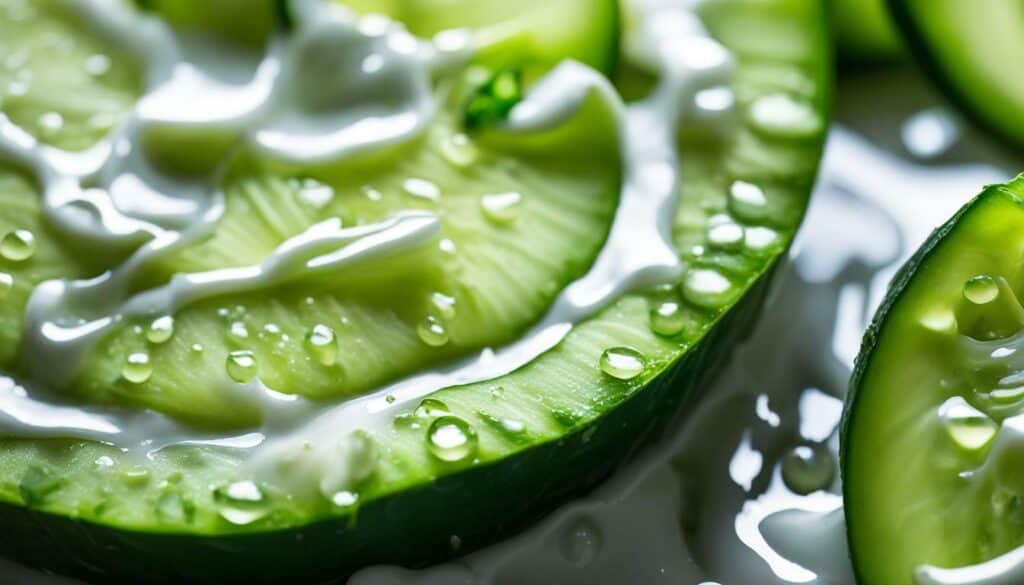
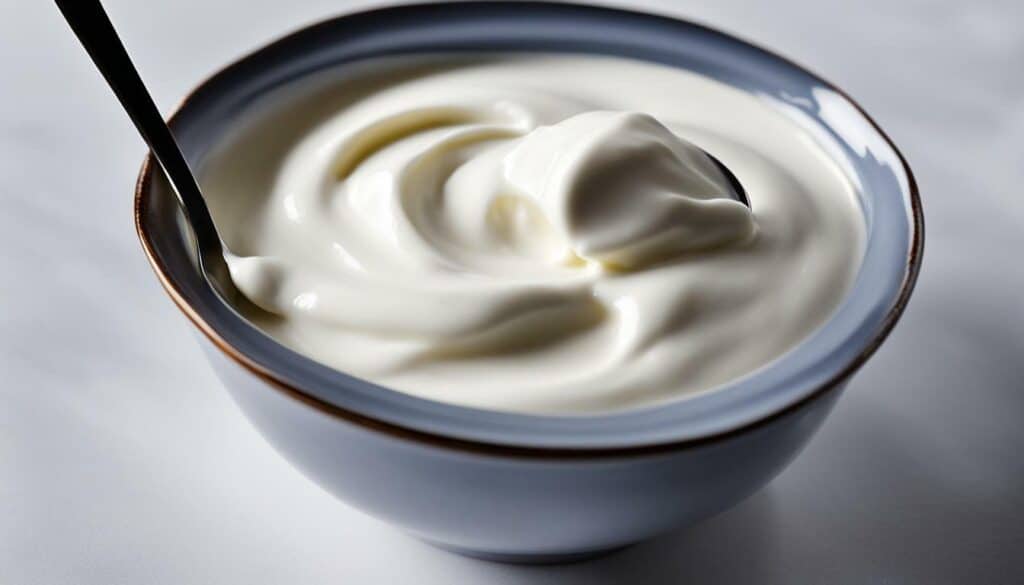



Leave a Reply